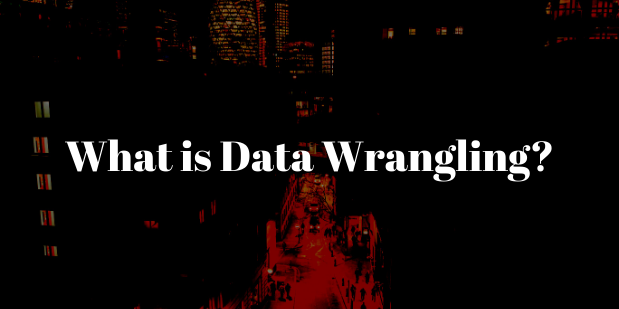What is Data Wrangling & How it Can Benefit Your Business?

In this advanced era, anything can be a really valuable source of information that can be used by many new businesses to establish themselves in the market. However, with every set of information comes the primary challenge of extracting the right and useful data that can really make sense for your business perspective. At this moment Big Data is taken into account. The nature of the information requires a certain kind of organization to be adequately assessed. Usually the various operations require clean data for the best results and data wrangling comes up with such sort of data which makes it very important for business.
What is Data Wrangling?
Data Wrangling is also known as Data Munging and can be defined as the process of transforming data from its original form into a set of information that comes from various sources to become a singular coherent data for further processing.
If we define the ‘Raw Data’ then it is the repository data like texts, images, database records that can be used yet can be processed further and fully integrated into the systems.
On the other end, the process of wrangling can be described as “digesting data” that can be eaten by the system to make it useful for the system. It can be described as a preparation stage for every other data-related operation.
If we dive deeper in the Data Wrangling then it is usually accompanied by Mapping. The Data Mapping is the element of the wrangling process that involves identifying source information of the field to their respective data fields. So we can say that Wrangling is used to transform data, Mapping is about connecting the dots between different elements.
The Purpose of Data Wrangling
The main purpose of data wrangling is to get data in a shape that the business can use it for better chances in the industry. Basically, it makes raw data usable & provides substance for further proceedings. The Data Wrangling acts as a preparation stage for the data mining operation. Further these two operations are coupled together as you can’t do one without another.
Data Wrangling covers the following processes:
Getting the data from various source
Piecing the data together as per the determined setting
Cleaning the data from the noise or erroneous, missing elements
The Data Wrangling is very demanding and time-consuming operation both from computational capacities and human resources. But Data Wrangling takes over half of what a data scientist does. Once the Data Wrangling done right makes a solid foundation for further data processing.
Data Wrangling Steps
Data Wrangling is very less self-descriptive, so must need to understand the term and every steps so you can know the sequence of the following process:
1. Preprocessing – The initial state that occurs right after acquiring all the information.
2. Converting the data into an understandable format so you have a user profile events record, so you can sort it by types of events and time stamps.
3. Cleaning data from noise, missing or erroneous elements.
4. Assigning & converting data from various sources into a coherent whole.
4. Final steps include matching the data with the existing data sets.
5. Filtering data through determined settings for the processing.
Data Wrangling Machine Learning Algorithms
There are various types of machine learning algorithms at play:
a. Supervised ML algorithms are used for standardizing & consolidating disparate data sources:
b. Classification is used to identify known patterns
c. Normalization is used to flatten the independent variables of data sets and restructure data into a more cohesive form.
d. Unsupervised ML Algorithms are used for exploration of unlabeled data:
e. Clustering is used to detect distinct patterns.
How Data Wrangling solves major Big Data/ Machine Learning Challenges?
Data Exploration
The data exploratory is really important in the data processing operation as it allows you to understand what kind of data you have and what all you can do with it. While it seems rather obvious more often than not this stage us skewed for the sake of seemingly more efficient manual approaches. But these approaches often leave out and miss a lot of valuable insights into the nature and the structure of data.
Automated Data Wrangling goes through data in more than one way and comes up with much more insights that can be worthwhile for your business operation.
Unified & Structured Data
Data can come to you in any form, either can be a glorious mess or golden opportunity to quickly benefit from it quickly. The raw data is mostly useless if it is not organized correctly beforehand. Data Wrangling and occasional mapping usually helps to set the data in a way that it would serve its purpose of use. This makes easy extraction of data from any insights for any emerging task. But the clearly structured data allows combining multiple data sets and gradually evolves the system with more effectiveness.
Data Clean-up from Errors/Noise/Missing Information
The problems like erros, noise, and other missing information are very common in the data set and there are few reasons for it.
1.Technical Glitches
2.Accidental Mislabeling
3.Human Error
It can impact the quality of the data processing and other important operations and can result in less effective business operations which surely no business wants. If we talk about the noisy data in machine learning then it can be very time consuming to get the quality data out of it. However, in the context of data cleaning, wrangling performs a few operations like:
Data Audit – This process can detect error or contradiction through statistical & database approaches.
Workflow Specification & Execution – It analyses the cause of errors by finding out their origin and effect in the context of the specific workflow. This is how it corrects the element or removes it.
Post-Processing Control – After the cleanup the results of the cleaned workflow are reassessed to find out the hidden or further complications in the data.
Minimized Data Leakage
Data Leakage is often considered as one of the biggest challenges of Machine Learning, even for the latest discoveries. In Data processing the thing is prediction relies on the accuracy of data, but if the data is uncertain then the prediction can be a wild guesstimation.
So, if we define data leakage then it refers to instances when the training of the predictive model uses data outside of the training data set. The result of such accurate data with incorrect predictions can affect your business operations in the most negative way.
It usually happens because of the messy structure of the data which doesn’t signify from where the data and what data has it is. The most common type of data leakage is when data from the test set bleeds into the training data set. However, the data wrangling & data mapping methods when done many times can reduce its impact to a possible neutral.
Data Wrangling Tools
Basic Data Munging Tools
Excel Power Query – The most used & basic structuring tool for manual wrangling.
OpenRefine – It’s a sophisticated solution, requiring programming skills.
Google DataPrep – It is usually used for exploration, cleaning & preparation.
Tabula – It is suitable for all types of data
DataWrangler- Used for Data cleaning and its transformation.
CSVkit – Used for data converting.
Data Wrangling in Python
Numpy – It is also known as numerical python and is the most basic package. Its library provides vectorization of mathematical operations on the NumPy array type and that helps in performance improvement and also speeds up the execution.
Pandas – It is designed for fast & easy data analysis operations. It is very useful for data structures with labeled axes. It has the facility of explicit data alignment that prevents common errors that occur from misaligned data coming from the sources.
Matplotlib – Python visualization module. It is perfect for line graphs, histograms, pie charts and other professional grade figures.
Plotly – Used for publication-quality graphs, line plots, area charts, scatter plots, nar charts, error bars, box plots, heatmaps, subplots, polar graphs and bubble charts.
Theano – It is a library for numerical computation similar to Numpy. It is designed to define, optimize, and evaluate mathematical expressions involving multi-dimensional arrays efficiently.
Data Wrangling in R
Dplyr – It is an essential data munging R package. Used as data framing tools and useful for operating on data by categories.
Purrr – It’s perfect for list function operations and error-checking.
Splitstackshape – Good for shaping complex data of sets and simplifying the visualization.
JSOnline – An amazing parsing tool.
Magrittr – It is used for wrangling scattered sets and putting them into a more coherent form.
Staying on the path of success while you have a new business requires a lot of concentration and effort. But with the machine learning algorithms, the process becomes more simpler and manageable. When you are able to gain insights from the data you have received you start making better decisions for your business and start gaining benefit out of it. In this competitive world take advantage of Data Wrangling and stand at a better position in the industry. Yet it doesn’t work without a little bit of experience first and that’s why you need data wrangling processes in place.
Read More: VerveLogic
# How Much Does It Cost to Make an App
# How to Hire iOS App Developer
# Tinder Alternatives: Best Dating Apps Like Tinder 2020
# How to Outsource Mobile App Development
# Big Data and Machine Learning
# Functional vs Non-Functional Requirements: Main Differences & Examples




